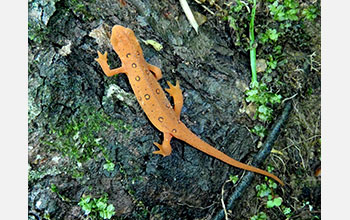Multimedia Gallery
Eastern newt in Roan Mountain State Park in Tennessee
An Eastern Newt (Notophthalmus viridescens) from Roan Mountain State Park in Tennessee.
More about this image
A study by National Science Foundation-funded researcher Karen Lips of the University of Maryland found that the deadly fungus Batrachochytrium salamandrivorans, which is wiping out salamanders in parts of Europe, will inevitably reach the U.S. through the international wildlife trade unless steps are taken to halt its spread.
After the fungus was discovered in Europe last year, Lips joined an international team of experts that tested more than 5,000 amphibians from four continents. Results of their study show the fungus probably originated in Southeast Asia 30 million years ago and reached Europe through the international trade in Asian newts, which are popular with amphibian fanciers. The fungus is lethal to at least a dozen European and North American salamander and newt species.
Lips, a UMD associate professor of biology and one of the world's top experts in amphibian diseases, and Cornell University Professor Kelly Zamudio screened about 1,400 frogs, salamanders and newts from sites in North and South America and found no trace of the fungus.
But the continued import of amphibians for the U.S. pet trade strongly increases the possibility of the fungus reaching the Americas. For example, the Chinese fire belly newt is a potential carrier of B. salamandrivorans, and more than 2.3 million of them were imported into the U.S. for the pet trade between 2001 and 2009.
Lips says scientists can act now to track, and ideally prevent, a disease outbreak from ravaging wild populations of newts and salamanders in the Americas. Current U.S. regulations focus on monitoring live animal imports to prevent the spread of diseases to humans and livestock, not to native wildlife, said Lips. She and other experts have already briefed Congressional staffers on the need to fill in this regulatory gap.
"If scientists and policymakers can work together on this, we have a rare opportunity to stop an epidemic from spreading around the globe with potentially deadly effect," says Lips.
[Research supported by NSF grants DEB 0815288 and DEB 1120161.]
Read more about this research in the Scripps news release Emerging disease could wipe out American, European salamanders. (Date image taken: June 2013; date originally posted to NSF Multimedia Gallery: Feb. 7, 2017)
Credit: Nicholas M Caruso, Department of Biological Sciences, University of Alabama
Images and other media in the National Science Foundation Multimedia Gallery are available for use in print and electronic material by NSF employees, members of the media, university staff, teachers and the general public. All media in the gallery are intended for personal, educational and nonprofit/non-commercial use only.
Images credited to the National Science Foundation, a federal agency, are in the public domain. The images were created by employees of the United States Government as part of their official duties or prepared by contractors as "works for hire" for NSF. You may freely use NSF-credited images and, at your discretion, credit NSF with a "Courtesy: National Science Foundation" notation.
Additional information about general usage can be found in Conditions.
Also Available:
Download the high-resolution JPG version of the image. (7.0 MB)
Use your mouse to right-click (Mac users may need to Ctrl-click) the link above and choose the option that will save the file or target to your computer.

 All images in this series
All images in this series